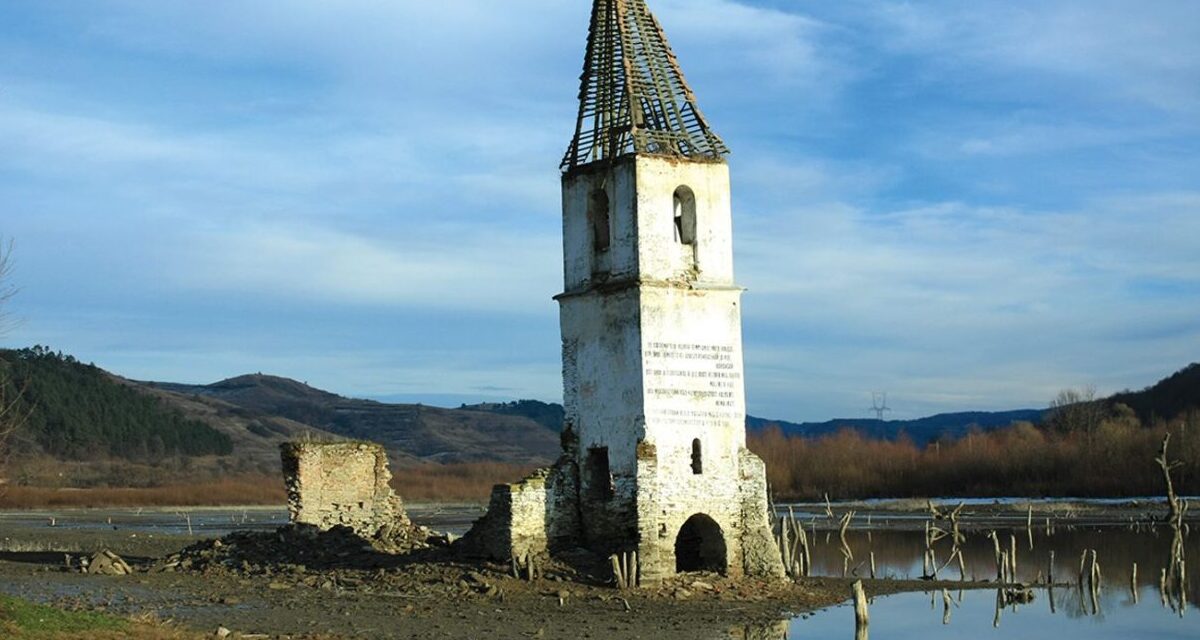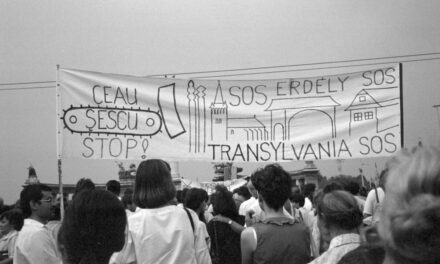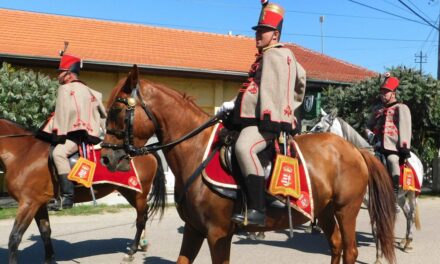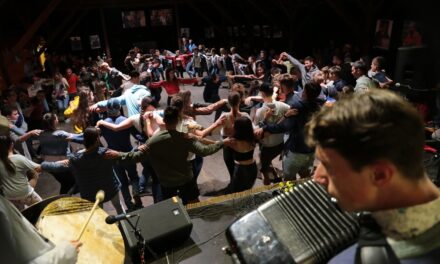Centuries of memories and stories of generations were swallowed up by the lake established in the Ceaușescu era at the site of Bözödújfalu in Transylvania; now a new memorial site helps heal wounds.
Five kilometers from Erdőszentgyörgy in Maros county, in the valley of the Küsmöd stream, Bözödújfalu was founded by families. Its first documented mention dates from 1566, and according to descriptions, it already had a church in the Middle Ages; later, instead of the existing church, a wooden church was built in 1740 and a stone church in 1784.
For years, the tower of the latter stretched like an orphan toward the sky in the middle of the huge lake created as a result of the communist village destruction and flooding.
The heart-wrenching sight of the truncated tower rising from the body of water spread over the site of the former settlement has become an eternal symbol of the horrors of the Ceaușescu era.
Since then, the Bözödújfalusi reservoir, also known as Bözödi lake, has become a favorite place for tourists and fishermen, in whose waters both bathers and those who want to relax find pleasure. Many people have no idea that so many lost dreams, broken lives, left behind memories and extinguished hopes lie at the bottom of the lake.
Under the water rests the memory of sad human destinies, once flourishing economies, childhood and family holidays, love, birth and death.
From the 17th century, Bözödújfalu was one of the central places of the Transylvanian Sabbatarian denomination, until in 1868 most of them converted to the Jewish faith. Most of them were then destroyed in the concentration camps of the Germans in the following century. In 1910, the village was still inhabited by seven hundred people, predominantly Hungarians. In 1939, an Orthodox church was started to be built next to the existing Catholic and Unitarian church and the synagogue, but in the end it was never finished, and in 1990 it was simply demolished.
The settlement has always been famous for its unique religious community: Roman Catholics, Unitarians, Reformed, Greek Catholics, Sabbatarians and Romanian Orthodox lived together in peace and harmony, helping each other.
This almost idyllic state was brought to an end by the word of power: in 1988, the construction of the nearby dam was completed, and the village was flooded a year before the fall of the Ceaușescu regime.
The 625-meter-long and 28-meter-high valley closing dam was built in the last years of the dictatorship. According to the official position, the catchment lake belonging to the dam was created for the purpose of flood protection, but according to many, this was more of a harbinger of the planned destruction of the village. Originally, a temporary water reservoir was planned for the area, which would have captured the flood waves of Kis-Küküllő and Küsmöd streams and would not have flooded Bözödújfalu. However, the investment was stopped by government decree. Before the work continued, the dam was redesigned, and the area of Bözödújfalu was included in the bed of the artificial lake created behind it.
The resettlement of the population began in 1985. It took nine years for Bözödújfalu to become the Bözödújfalusi reservoir.
The families carried their lives by boat and canoe, and those living higher up by trailer.
The humiliation of the inhabitants of the settlement was compounded by the fact that they received ridiculously little compensation from the state for their suffering: the authorities imposed amounts between ten and thirty-five thousand lei, but a Dacia car also cost at least seventy thousand lei.
By 1994, the village and its two churches were under water, only twelve houses were saved from the flooding, and they are still inhabited today. According to local legend, when the water finally covered Bözödújfalu, the swallows arriving in the spring circled over the lake for weeks in search of their nests.
Some of the residents - mainly the elderly - were moved to the neighboring town of Erdőszentgyörgy, while the rest were relocated to more than thirty settlements throughout Transylvania. They went to Hármasfalu, Havadtő, Gyulakuta, Fületelke, Bözöd, Etéd, Kőrispatak; there were those who settled along the Kis- and Nagy-Küküllő, in the vicinity of Székelykeresztúr, Székelyudvarhely, Segesvár and Marosvásárhely; and there were those who went to the side of Nyárád. In fact, we even know of people who have migrated far away: former Bözödú villagers live in Hungary, Austria, Israel and Australia.
As a result of the tragedy, hundreds of people became homeless. Although the evicted did not find a new place to live, they all remained Bözödúj villagers in spirit.
In 1995, with the intervention of Árpád Sükösd, a former resident of Bözödújfalu, a wailing wall was built next to the reservoir, where the village's First World War memorial, which was lifted out of the water in 1996, once stood.
These words preserve the memory of the former settlement: "Bözödújfalu rests at the bottom of the lake, the former residents of its 180 houses scattered around the world still mourn. It was destroyed and flooded by the evil executors of the dictatorship, thereby eliminating a unique historical-religious community in which families of different nationalities and religions lived together for centuries, respecting and loving each other, in exemplary peace. Now the petitions of the Catholics, Unitarians, Greek Catholics and Székely Sabbatarians have been silenced forever. Let this place be a place and a symbol of religious peace."
Every year on the first Saturday of August, the descendants of the settlement gather here to talk and remember their village.
Next to the wailing wall, a bell and belfry, as well as a headstone village, were erected, which were made by woodcarvers living in the Carpathian Basin, and which, according to house number, street by street, reflects the former settlement.
In the Rhédey Castle in Erdőszentgyörgy, a memorial room announces the existence of Bözödújfalu, a model of the former settlement can be viewed, and the church's old bell can also be rung.
The tower rising out of the lake and becoming a symbol of the destruction of the village collapsed in 2014.
Of course, not overnight - the old churches have deteriorated over the years. Local residents, mainly Roma, carried away the stones from their walls at low water, and in 2009, the roof of the tower of the baroque Catholic church collapsed in a big storm. The heart-wrenching sight of this truncated tower was burned into people's memories forever.
Rumor has it that some people even wanted to steal the cross at the top of the church, because they assumed that the orb would tell them where the church's treasures were hidden. In the end, it was saved, and after its restoration, it was exhibited in Erdőszentgyörgy. The Madonna statue was also placed here, which is one of Transylvania's most valuable Marian monuments.
After the collapse of the tower in 2014, the first plans were born that a new memorial, a symbolic church, should be built on the edge of the lake. The former residents were afraid that even the reputation of the settlement would be lost if there was no messenger to remind them of it.
In 2017, the reservoir's water level was lowered by more than eight meters because a part of the bridge connecting the control tower standing in the water with the dam broke off. Thus, the remains of the former settlement became visible again.
Work on the building, named the Church of Unity, began in the fall of 2018, but the lack of financial resources and then the years of the pandemic delayed the construction. The works started again in 2023.
Attila Zoltán Csibi, the mayor of Erdőszentgyörgy, put it this way: "The house of worship built with public donations represents all the denominations of the flooded settlement, which is why it is called the Church of Unity." Donations came from many countries, from Canada to Australia, and in addition to donors from Transylvania and the motherland, the local governments of Maros county and Hungary also supported the works. According to Csibi, the final value of the donations is between 200 and 300 thousand euros.
The building, reminiscent of an old Catholic church, was built on the shore of the lake, without doors, windows and a roof. In March 2024, the tower helmet was also added to the roof of the church - like a crown. It is expected that a lower tin covering will be added to the special, wooden roof covered with glass.
Among the promises of the municipality of Erdőszentgyörgy is the modernization of the road leading from the former memorial park at the end of the village to the church, so this section of a few hundred meters is also included in the municipal project aimed at paving the streets.
With this, it seems, an old dream has come true, and the church of Belonging has been completed, the ceremonial inauguration of which will take place on August 3 at an ecumenical service at the annual meeting of the Bözödúj villagers.
The program, colloquially known as the Romanian Village Destruction, officially known as the Village Settlement Plan, was a settlement and population settlement plan in the Socialist Republic of Romania that took place in 1988-89. The official start of the program can be considered April 29, 1988, when Party General Secretary Nicolae Ceauşescu announced the so-called settlement systematization plan. Although the aim of the program was officially settlement planning, the suppression of the Hungarian and German nationalities, as well as the eradication of traditional social relations in general, was also a clear political intention on the part of the Romanian leadership. The destructive processes were put to an end by the revolution that broke out in December 1989 and the fall of the communist dictatorship.
Cover image: The Bözödújfalus Catholic church in November 2008
Source: Wikipedia












